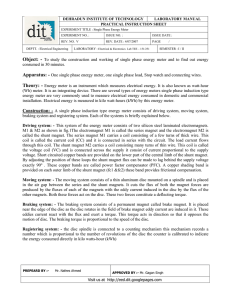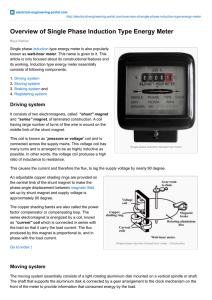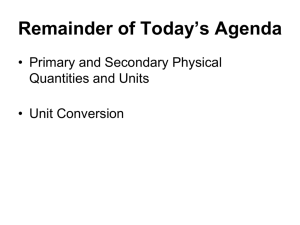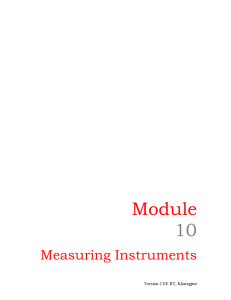by:- N.K.Bhati Electro-mechanical meters
advertisement
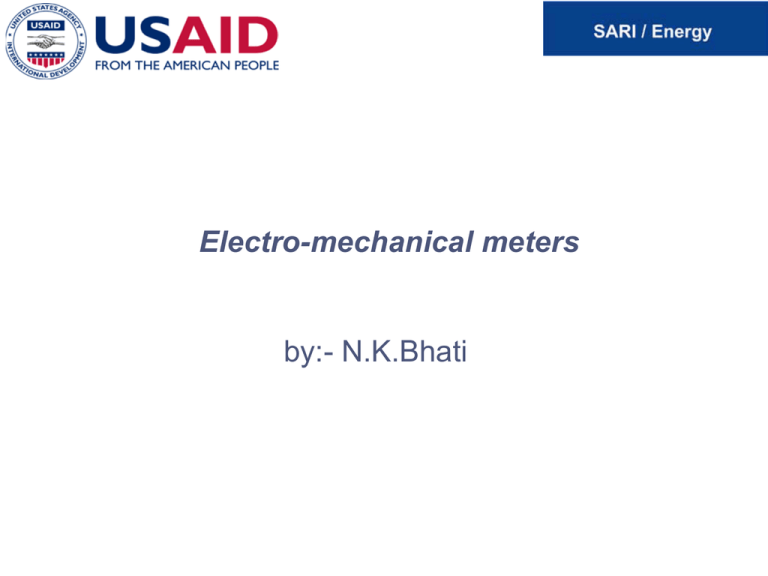
Electro-mechanical meters by:- N.K.Bhati Some familiar meters Electromechanical meters • Energy is measured by means of the energy meter (watt-hour-meter) • Energy meter is an integrating instrument and takes into account both of the electrical quantities (v, i,) and time(t). • Ferrari principle (1884) used in watt-hour meters • Induction watt-hour meters invented in 1889 What is an energy meter? Current Sensing Voltage Sensing t Register Integrator Multiplier Working principle, basic parts • An induction-type / electromechanical energy meter, the most widely used energy meter for over a century, works on the principle that when a current carrying conductor is acted on by a magnetic field, the force which it experiences is proportional to the current and the field. • It basically consists of the following four systems : • • • • Driving system consisting of two electromagnets Moving system consisting of an aluminium disc Braking system consisting of a permanent magnet Registering system consisting of gear train and counter Construction • An induction type wattmeter consists of an aluminium disc mounted on a spindle, a current coil and a voltage coil, a permanent magnet and a counter. • The current coil is connected in series with the load and the voltage coil connected across the supply. • These two coils generate magnetic fields , and are arranged in such a manner that, the eddy currents developed in the disk forces the aluminium disc to rotate and the permanent magnet acts as a brake on the disc. The disc rotates at a speed N which is proportional to power. • The worm and the worm wheel provided with the spindle moves the counter. Construction • • • • • • • Mechanism of electro mechanical induction meter. (1) - Voltage coil - many turns of fine wire encased in plastic, connected in parallel with load. (2) - Current coil three turns of thick wire, connected in series with load. (3) - Stator - concentrates and confines magnetic field. (4) - Aluminium rotor disc. (5) - rotor brake magnets. (6) - spindle with worm gear. (7) - display dials - note that the 1/10, 10 and 1000 dials rotate clockwise while the 1, 100 and 10000 dials rotate counter-clockwise. Magnetic circuit and coils Stator of induction-type watt-hour meter, showing the windings Basic parts Basic elements of an induction-type watt-hour meter. Single phase EM meter (Coils front and back view) Reverse stop, brake magnets and error adjustment 3 phase meter Errors and adjustments : • Phase and speed errors: A short- circuited (lag) coil is placed on the voltage coil pole. The resistor in the circuit of this coil may constitute the "lag" or power-factor adjustment of the meter, but in many meters this adjustment is obtained by movement of a "lag plate," and the resistor should not be disturbed. Alternately shading bands of copper are used. This is also for adjusting errors on power factors. • FRICTION. To compensate for friction, additional torque must be introduced. This usually is accomplished by placing a movable short-circuited turn of large cross section in part of the field of the voltage (potential) coil. This also serves as a "lightload" adjustment and CREEP adjustment. Errors and adjustments : • Brake magnet: The necessary retarding action is provided by a magnetic brake consisting of a permanent magnet operating on the aluminum disk. This retarding action is adjustable and is known as the "full load" meter adjustment. Two methods of varying the braking effect of the magnet are in common use. The first is to adjust the position of the magnet; moving it outward radialy toward the edge of the disk increases the braking effect and decreases speed and registration. In the second method, the magnet is fixed, and the braking effect is adjusted by a magnet shunt which bypasses part of the magnet flux of the permanent magnet, as shown in Figure. Magnetic shunt method of adjusting speed of disk. Thanks
